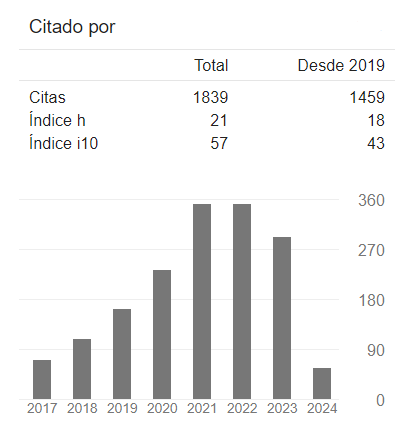Administrative Law from Colombian Cinema: Two Women and a Cow and The Embrace of the Serpent
DOI:
https://doi.org/10.24142/raju.v16n33a9Keywords:
Cinema, Law, Administrative Law, Two Women and a Cow, Embrace of the SerpentAbstract
The article is one of the results of the thesis entitled: Administrative law from the new constitutional context from the Colombian cinema: Two women and a cow (Bahamón, 2015) and Embrace of the snake (Guerra, 2015), carried out as final work for the Master's Degree in Administrative Law at the Universidad Autónoma Latinoamericana. In the article, Cinema and Law are presented as two cultural productions of deep transcendence in current societies and, particularly, cinema approaches new views on various social, political and legal phenomena, which allows it to evidence nuances, readings and points of view. For this reason, the article aims to rethink Administrative Law using film analysis as a tool to decipher the connections between cinema and this legal discipline. To this end, two films are analyzed in order to make visible their connections with Administrative Law. In Two Women and a Cow (2015) it is evident that the film constitutes an interpellation from the seventh art to a society that does not recognize itself in the memory of the war it has suffered and to a State that does not effectively guarantee the vital securities, rights and properties of citizens. In the case of The Embrace of the Serpent (2015) the film constitutes a call for the State to promote a broader and holistic vision of nature that recognizes the integrality and co-dependence of all natural elements in the ecosystem. Both films make a call to the State that implies generating a paradigm shift, profoundly and fundamentally transforming public administration, orienting the vocation of public service to the common good.
References
Atehortúa, C. (2009). Aproximación a los estudios de derecho y cine. El cine como medio de aproximación al derecho. Editorial Universidad Externado de Colombia.
Bahamon, E. (Director). (2015). Dos mujeres y una vaca [Película]. Doble Sentido S A S.
Bustos, P. (2010, del 13 al 15 de septiembre). Educación artística. El cine como herramienta eficaz para un aprendizaje concreto, activo y reflexivo: una experiencia en aula. Congreso Iberoamericano de Educación. Metas 2021. Buenos Aires, Argentina.https://www.adeepra.org.ar/congresos/Congreso%20IBEROAMERICANO/EDUCARTISTICA/RLE3324_Bustos.pdf
Congreso de la República de Colombia. (1947, diciembre 18). Decreto 2811. Código Nacional de Recursos Naturales Renovables y de Protección al Medio Ambiente. Diario Oficial, núm. 34.243 http://www.secretariasenado.gov.co/senado/basedoc/decreto_2811_1974.html
Constitución política de Colombia - Const. (1991). Art. 2. Legis.
Corte Suprema de Justicia, Sala de Casación Civil. (2018, abril 5). Sent. STC-4360. M. P. Luis Armando Tolosa Villabona.
Garrido, F. (1966). Tratado de Derecho Administrativo. IEP.
Guerra, C. (Director). (2015). El abrazo de la serpiente [Película]. Ciudad Lunar Producciones.
Jèze, G. (1928). Los principios generales del Derecho Administrativo. Reus.
Martínez, J. (1999). La imaginación jurídica. Debate.
Red Internacional para los Derechos Económicos, Sociales y Culturales - Red-DESC. (2018). Sentencia de la Corte Suprema de Colombia protege a generaciones futuras y la selva amazónica en caso sobre cambio climático. https://www.escr-net.org/es/caselaw/2019/stc-4360-2018
Rosenstone, R. (1995). La historia en la pantalla. En J. Montero y M. Paz. (Coords.). Historia y cine: realidad, ficción y propaganda (pp. 13-34). Complutense.
Santofimio, J. (2005). Tratado de Derecho Administrativo, tomo II. Editorial de la Universidad Externado de Colombia.
Sherwin, R. K. (2000). Nomos and Cinema Symposium: Law and Popular Culture. UCLA Law Review,48(1), 1519-1543. https://digitalcommons. nyls.edu/cgi/viewcontent.cgi?article=1261&context=fac_articles_chapters
Tarkovski, A. (2002). Esculpir en el tiempo. Reflexiones sobre el arte, la estética y la poética del cine. E. Banús (trad.). RIALP.
Zanobini, G. (1954). Curso de derecho administrativo. Parte general. Arayú.
Published
How to Cite
Issue
Section
License
Copyright (c) 2021 Juan Pablo Quintero López, Daniel Felipe Castaño Mesa, Juliana Andrea Pérez Betancurt

This work is licensed under a Creative Commons Attribution-NonCommercial-ShareAlike 4.0 International License.
La rivista consente all'autore (s) di mantenere i diritti di pubblicazione senza restrizioni.
Le journal permet à l'auteur (s) de conserver les droits de publication sans restrictions.
The journal allows the author (s) to retain publication rights without restrictions.
La revista le permite al autor(es) retener los derechos de publicación sin restricciones
Die Zeitschrift ermöglicht es dem / den Autor (en), Veröffentlichungsrechte ohne Einschränkungen zu behalten.
A revista permite que os autores mantenham os direitos de publicação sem restrições.











































